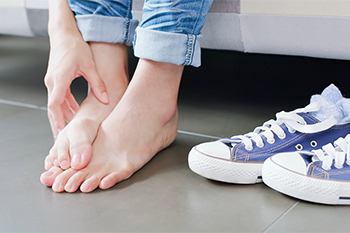Can Athlete’s Foot Be Avoided?

A variety of different fungi can cause a skin infection known as athlete’s foot. It can be quite uncomfortable and may have symptoms that consist of itching, red, and dry skin. The medical name for athlete’s foot is referred to as tinea pedis which lives in warm and moist environments. These can include public swimming pools, shower room floors, and locker rooms. It is suggested to wear appropriate shoes while in these types of areas as this may help to avoid getting athlete’s foot. Additionally, other effective prevention methods can consist of trimming the toenails correctly and avoiding wearing shoes or socks that are not made of breathable materials. The feet will feel better when they are kept dry and cool, and it is beneficial to air out any shoes that are worn approximately every other day. Athlete’s foot can be difficult to treat and may be recurring. If you are afflicted with this condition, it is advised that you schedule an appointment with a chiropodist who can prescribe the necessary medication.
Athlete’s foot can be uncomfortable and unsightly. To learn more about preventing and treating this condition, please consult with one of the chiropodists from The Footcare Centre. Our chiropodists will assess your condition and provide you with quality foot and ankle treatment.
What Is Athlete’s Foot?
Athlete’s foot refers to an infection of the skin on the feet that is caused by a fungus. This fungus is contagious and thrives in warm and moist environments. It is often spread in common areas such as public pools, locker rooms, and showers. It can also spread when sharing personal items, like shoes or towels, with an infected person.
Symptoms
The symptoms of athlete’s foot may include:
Itching, stinging, or burning of the skin on the feet
Cracking or peeling skin, especially between the toes and on the soles of the feet
Scaly, red rash on the foot
Blisters
Foul odor
Treatment
Treatment for athlete’s foot typically involves using over-the-counter topical antifungal medications on the feet. When over-the-counter options are ineffective, you may need to take prescription oral medications or topical antifungal drugs, or a combination of both.
Prevention
Preventing athlete’s foot places an emphasis on good foot hygiene practices.
You can prevent athlete’s foot by:
Washing and drying your feet thoroughly every day
Wearing shoes when walking in public areas
Not sharing personal items, like shoes or socks, with others
Wearing shoes and socks made out of breathable materials
If you have any questions, please feel free to contact our office located in . We offer the newest diagnostic and treatment technologies for all your foot care needs.
